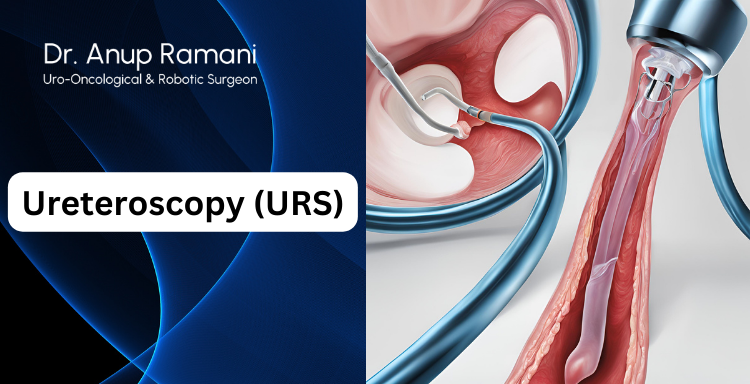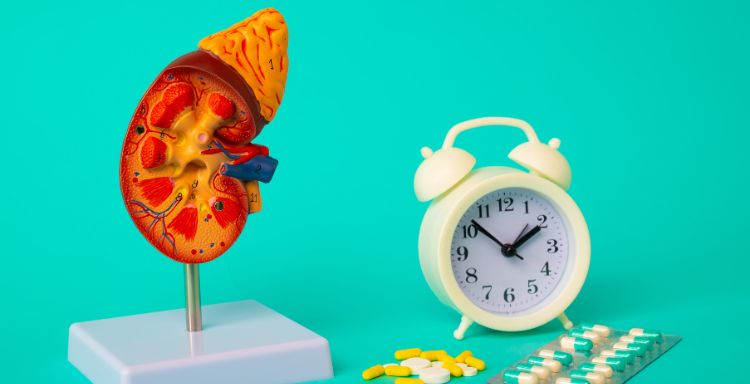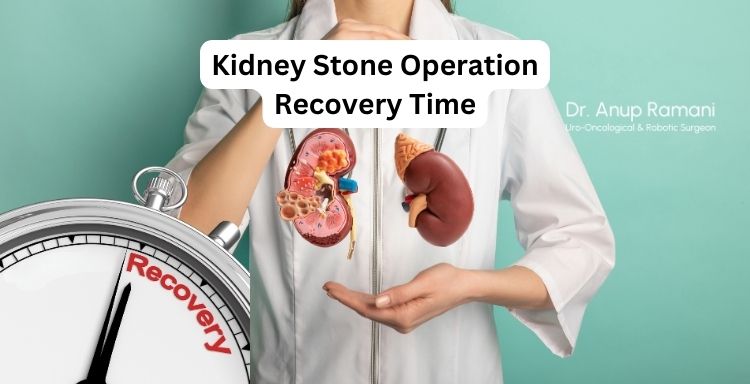Dr Anup Ramani @ Copyright 2024
By Dr. Anup Ramani
Introduction
Kidney stones are a common yet painful condition that often requires surgical intervention. While smaller stones can sometimes be passed naturally, larger or more stubborn stones may require medical procedures to remove them. Understanding the recovery time and process after a Kidney Stone Removal Surgery is essential for managing expectations and preparing for the healing journey. This comprehensive guide will walk you through the different types of kidney stone surgeries, what to expect during recovery, and how to make the process as smooth as possible.
Understanding Kidney Stone Surgeries
1. Ureteroscopy (URS)
Ureteroscopy is a Minimal invasive procedure where a small, flexible tube (ureteroscope) is passed through the urethra and bladder to the ureter, where the kidney stone is located. The stone is either broken into smaller pieces or removed entirely.
- Recovery Time: The recovery from kidney stone ureteroscopy is relatively quick. Patients can usually resume light activities within a couple of days, but it may take up to a week for a complete recovery.
- Pain Management: Some discomfort, including mild pain and burning during urination, is common but typically manageable with medication.

2. Laser Kidney Stone Surgery (RIRS)
Retrograde Intrarenal Surgery (RIRS) uses a laser to break down the stone into small pieces, which are then removed. This method is often chosen for stones that are difficult to reach.
- Laser Surgery for Kidney Stones Recovery Time: Recovery from kidney stone laser removal surgery is generally quicker than traditional surgeries. Patients can often leave the hospital the same day or the day after, resuming daily activities within a few days.
- Pain and Symptoms: Mild pain or a feeling of pressure in the bladder is common but usually subsides quickly.

3. Percutaneous Nephrolithotomy (PCNL)
PCNL is used for larger or more complex stones. The surgeon makes a small incision in the back to insert a nephroscope and remove or break up the stones.
- Recovery Period: This surgery requires a longer recovery time, typically around 1 to 2 weeks. Patients may need to stay in the hospital for 1 to 3 days post-operation.
- Post-Op Care: Pain management and rest are crucial, and strenuous activities should be avoided for several weeks.
Kidney Stone Operation Recovery Time: What Influences It?
Several factors influence the kidney stone operation recovery time, including the type of surgery, the size and location of the stone, and the patient’s overall health. Here’s a detailed look at these factors:
1. Type of Surgical Procedure
- Ureteroscopy and Laser Treatment: As Minimal invasive surgeries, these generally have shorter recovery times, typically ranging from a few days to a week.
- Percutaneous Nephrolithotomy (PCNL): Being more invasive, PCNL requires a longer recovery period, often between 1 to 2 weeks.
2. Size and Location of the Kidney Stone
- Larger stones or those located in hard-to-reach areas may result in a more complex surgical removal of kidney stones, which could extend the recovery period.
- Stones that are easy to access usually mean a faster healing process.
3. Patient’s Overall Health
- Patients with underlying conditions like diabetes or kidney disease may experience longer recovery times.
- Healthy individuals often recover more quickly and with fewer complications.

Post-Surgery Expectations
The recovery process from a Kidney Stone Removal Surgery can vary widely from person to person, but there are some common experiences most patients share.
1. Hospital Stay and Initial Recovery
- Hospital Discharge: For Minimal invasive procedures like ureteroscopy or RIRS kidney stone treatment, patients can often go home the same day. However, with PCNL, a hospital stay of 1-3 days is common.
- Immediate Post-Op Symptoms: Pain, nausea, and a need to urinate frequently are common right after surgery. Pain is usually managed with over-the-counter or prescribed painkillers.
2. At-Home Recovery Tips
- Hydration: Drinking plenty of fluids is crucial for flushing out any residual stone fragments.
- Diet: A balanced diet rich in fruits and vegetables can speed up the healing process. Avoid foods high in sodium and oxalates, as they can contribute to new stone formation.
- Medications: Follow your doctor’s instructions for taking medications, including pain relievers and antibiotics, to avoid complications.
Managing Pain and Discomfort
Pain and discomfort are common after any surgical procedure to remove kidney stones, but there are ways to manage them effectively.
- Pain Relievers: Non-steroidal anti-inflammatory drugs (NSAIDs) are commonly prescribed to alleviate pain.
- Heat Therapy: A heating pad can provide relief from muscle spasms and soreness in the lower back.
- Urinary Symptoms: Burning during urination is normal after a ureteroscopy. Drinking water and using prescribed medications can help ease these symptoms.
Returning to Normal Activities
Most people are eager to get back to their daily routines after kidney stone extraction surgery. Here’s a general timeline for resuming activities:
- Light Activities: Walking and light chores can usually be resumed within 2-3 days.
- Work: Depending on the nature of your job, you may return to work within a week. However, if your job involves heavy lifting, you may need to wait longer.
- Exercise: Strenuous physical activities should be avoided for at least 2 weeks or until your doctor gives the green light.
Special Considerations for Mumbai Patients
For those undergoing kidney stone treatment in Mumbai, cost and quality of care are crucial factors.
1. Kidney Stone Laser Treatment Cost in Mumbai
The cost of kidney stone laser treatment in Mumbai can vary based on factors like the hospital, surgeon’s experience, and the complexity of the case.
- Affordable Options: Mumbai offers various hospitals and clinics with affordable yet high-quality kidney stone treatments. Always consult multiple providers to find the best option.
- Insurance Coverage: Many health insurance plans cover kidney stone operation costs in Mumbai, so it’s worth checking with your provider.
2. Finding a Kidney Stone Specialist in Mumbai
The city is home to some of the best kidney stone specialists in Mumbai, who are well-versed in both traditional and Minimal invasive surgical techniques. Research and choose a specialist who has a proven track record in successful kidney stone surgeries.
FAQs - Kidney Stone Operation Recovery
What is the average recovery time for kidney stone removal?
The average recovery time for kidney stone removal varies. Minimal invasive procedures like ureteroscopy usually have a recovery time of about a week, while more invasive surgeries like PCNL may take up to two weeks or more.
How long does it take to return to normal activities after kidney stone surgery?
Most people can resume light activities within a few days, but full recovery may take up to 2 weeks, depending on the procedure.
Is there a way to speed up recovery?
Staying hydrated, following your doctor’s post-op instructions, and avoiding strenuous activities can help speed up recovery. A nutritious diet and regular, gentle exercise can also be beneficial.
Are there any risks involved in kidney stone surgery?
While kidney stone surgeries are generally safe, there are some risks, including infection, bleeding, and damage to surrounding organs. Your doctor will discuss these risks before the operation.
How do I find a kidney stone specialist in Mumbai?
You can find a kidney stone specialist in Mumbai by researching online reviews, consulting with your primary care physician, or seeking recommendations from people who have undergone kidney stone treatment.
Conclusion
Understanding the recovery time and process after a kidney stone surgical treatment is crucial for a smooth healing experience. Whether you’re undergoing a surgical procedure for kidney stones or opting for a less invasive option, knowing what to expect can ease anxiety and aid in a quicker recovery. If you’re based in Mumbai, you have access to top-notch care and a wide range of affordable surgical options. Always consult your healthcare provider for personalized advice to ensure the best outcome.
About Author

Uro-Oncological & Robotic Surgeon
Dr. Anup Ramani is a robotic uro-oncological surgeon and an internationally recognized expert in robotic surgery for prostate, kidney and urinary bladder cancers. With more than two decades of robotic experience and 2,000+ robotic procedures, he brings unmatched precision and outcomes to complex uro-oncology cases. He is widely published in his field and is known for a personal, transparent approach-often spending over an hour in initial consultations to educate patients on its disease, surgery and recovery. His expertise spans prostate cancer treatment, kidney and bladder cancer surgery, adrenal gland surgery, kidney stone treatment, penile cancer surgery and enlarged prostate management. Dr. Ramani advocates the advantages of robotic surgery-magnified 3D vision, tremor-filtered precision, minimal scarring, lower blood loss and faster recovery-helping patients return to life sooner.
Table of Contents
Recent Blogs
Best Uro-Oncological surgeon
Specialist in India for Robotic Surgery
MCh, DNB, MS, DNB
Dr. Anup Ramani
CONTACT
Uro-Oncologist in India,
Best Robotic Surgeon for Uro Oncology Surgery
1407, One Lodha Place Next to World Towers Senapati Bapat Marg, Worli, Mumbai. 400013.
Dr Anup Ramani @ Copyright 2024 – Website Maintenance, SEO & GEO by Opal Infotech
- Partial penectomy is done in cases where glans and distal penis is involved with carcinoma.
- Partial penectomy is a type of organ-preserving surgery. Preservation of sexual and micturational function depends on the surgical dissection and reconstruction of residual urethra.
- Patients who develop stones in the kidney or ureter, often experience severe pain.
- This condition usually needs a procedure to remove the kidney stones.
- This procedure is called ureteroscopy and is performed very commonly.
- It does not require any cuts and hence it is painless.
- The procedure is performed with an endoscope inserted through the penis under spinal anesthesia.
- The scope is inserted through the penis into the kidney and stones are dissolved with a laser.
- The procedure takes about 40-50 minutes.
- A catheter (urine pipe) is kept after the procedure to drain the bladder. A stent is kept in the kidney at the same time.
- Patient is mobile and walking in the room the same evening.
- Hospital stay is one night and patient is discharged the next day after removal of the catheter.
- Patient has to come back after six weeks to remove the stent in the kidney.
- Patients can resume office a week after surgery and heavy activities like running, weight lifting, a month after the procedure.
- We offer fixed packages for this procedure which can be obtained by calling our helpline +91 9967666060.
- Men with an enlarged prostate, which is a normal ageing changes, often experiencing difficulty passing urine. This condition usually needs a procedure to trim the prostate and relieve the blockage.
- This procedure is called TURP and is performed very commonly.
- It does not require any cuts and hence it is painless.
- The procedure is performed with an endoscope inserted through the penis under spinal anaesthesia.
- The overgrown prostate is dissolved with a laser bloodlessly.
- The procedure takes about 40 minutes.
- A catheter (urine pipe) is kept after the procedure to drain the bladder.
- Patient is mobile and walking in the room the same evening.
- Hospital stay is two nights and patient is discharged with the catheter, which is removed after 4 days.
- Patients can resume office a week after surgery and heavy activities like running, weight lifting, a month after the procedure.
- We offer fixed packages for this procedure which can be obtained by calling our helpline +91 9967666060.
-
Robotic adrenalectomy is a sophisticated, complex surgery and it is very important that an experienced surgeon performs this surgery to avoid major complications.
-
Once the anesthesia is done, and patient positioned, three micro cuts (3mm each) are made in the patient’s abdomen.
-
The arms of the Da Vinci robot are connected to the cuts via ports (tubes).
-
Dr. Ramani then sits in the controlling console to perform the surgery.
-
On an average, a robotic adrenalectomy takes one hour.
-
The surgery is almost completely bloodless and there has never been any need to transfuse blood after surgery.
-
A urine catheter and bag to drain the bladder is inserted during surgery.
-
A tiny drain pipe may be inserted in the surgical side of the abdomen, connected to a bag.
-
Patient is kept nil-by-mouth the day of the surgery, with IV fluids. Sips of water are started the next day and solid food by day three.
-
The drain pipe, if kept, is removed in the room on day 2 after surgery.
-
The catheter is removed on day two after surgery.
-
Total hospital stay for robotic adrenalectomy is 4 nights (including night before surgery).
-
Post discharge, a doctor from the surgical team visits the patient at home/ hotel room once every day.
On the day of discharge, patient is totally self-sufficient. They are able to walk freely without any pain, dress themselves, shower, toilet and they do not need to hire any nurse or help at home. Almost all patients are back to work within 2 weeks of surgery.
Heavy activities like running, weight lifting can be resumed after a month
Follow up after an adrenalectomy is in the form of CT scans, once a year for 5 years.
Local patients usually meet Dr. Ramani after two weeks to discuss report.Outstation patients are counselled on a phone consultation.
- Dr. Ramani is one of the very few surgeons in India who has the expertise to perform a robotic surgery for bladder cancer, which includes removing the urinary bladder and reconstructing a new bladder robotically.
- Robotic radical cystectomy is an extremely sophisticated, complex surgery and it is very important that an experienced surgeon performs this surgery to avoid major complications.
- Once the anaesthesia is done, and patient positioned, six micro cuts (3mm each) are made in the patient’s abdomen.
- The arms of the Da Vinci robot are connected to the cuts via ports (tubes).
- Dr. Ramani then sits in the controlling console to perform the surgery.
- On an average, a robotic radical cystectomy with an ileal conduit takes 3-4 hours.
- The surgery is almost completely bloodless and there has never been any need to transfuse blood after surgery.
- A urine catheter and bag to drain the new bladder is inserted during surgery.
- Two tiny drain pipe in inserted in the surgical side of the abdomen, connected to a bag.
- Patient is kept nil-by-mouth for 4 days after surgery with IV supplementation of patient’s daily requirements of calories, fats, carbohydrates, proteins and electrolytes.
- The drain pipes are removed in the room on day 3-5 after surgery.
- Total hospital stay for radical cystectomy is 8 nights (including night before surgery).
- Post discharge, a doctor from the surgical team visits the patient at home/ hotel room once every day.
- On the day of discharge, patient is totally self-sufficient. They are able to walk freely without any pain, dress themselves, shower, toilet and they do not need to hire any nurse or help at home.
- Almost all patients are back to work within 6 weeks of surgery. Heavy activities like running, weight lifting can be resumed after two months.
Follow up after a radical a cystectomy is in the form of CT scans, once a year for 5 years.
Histopathology report: Local patients usually meet Dr. Ramani after two weeks to discuss report.
Outstation patients are counselled on a phone consult. Depending on the report, patient may or may not need chemotherapy after surgery.
If chemo is needed, patients may choose to get it done with a medical oncologist of their choice or avail the services of one of the four medical oncologists on our team.
- Robotic partial nephrectomy is a sophisticated, complex surgery and it is very important that an experienced surgeon performs this surgery to avoid major complications. Robotic radical (total) nephrectomy is
- relatively easier but still requires significant experience to consistently deliver results.
- Once the anaesthesia is done, and patient positioned, five micro cuts (3mm each) are made in the patient’s abdomen.
- The arms of the Da Vinci robot are connected to the cuts via ports (tubes).
- Dr. Ramani then sits in the controlling console to perform the surgery.
- On an average, a robotic radical nephrectomy takes one hour and a robotic partial nephrectomy takes about an hour and half.
- The surgery is almost completely bloodless and there has never been any need to transfuse blood after surgery.
- A urine catheter and bag to drain the bladder is inserted during surgery.
- A tiny drain pipe in inserted in the surgical side of the abdomen, connected to a bag.
- Patient is kept nil-by-mouth the day of the surgery, with IV fluids. Sips of water are started the next day and solid food by day three.
- The drain pipe is removed in the room on day 3 after surgery. The catheter is removed on day two after surgery.
- Total hospital stay for radical/partial nephrectomy is 4 nights (including night before surgery).
- Post discharge, a doctor from the surgical team visits the patient at home/ hotel room once every day.
- On the day of discharge, patient is totally self- sufficient.
- They are able to walk freely without any pain, dress themselves, shower, toilet and they do not need to hire any nurse or help at home.
- Almost all patients are back to work within 2-3 weeks of surgery.
- Heavy activities like running, weight lifting can be resumed after a month.
- Follow up after a radical/partial Nephrectomy is in the form of CT scans, once a year for 5 years.
- Local patients usually meet Dr. Ramani after two weeks to discuss report.
- Outstation patients are counselled on a phone consultation.






